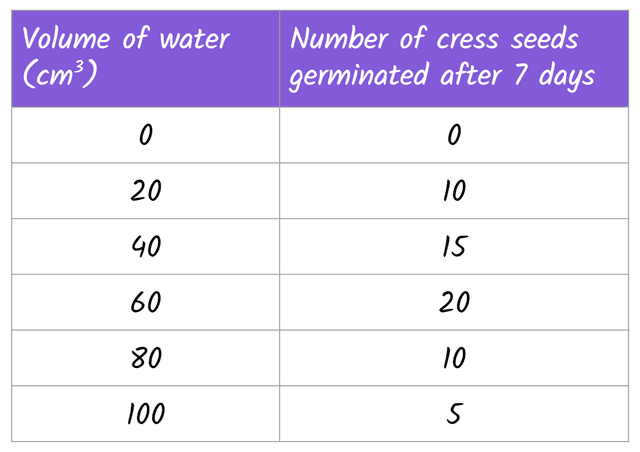Myths about teaching can hold you back
- Year 9
Factors affecting seed germination: data analysis
I can describe and explain the results of an investigation into factors affecting seed germination.
- Year 9
Factors affecting seed germination: data analysis
I can describe and explain the results of an investigation into factors affecting seed germination.
These resources were made for remote use during the pandemic, not classroom teaching.
Switch to our new teaching resources now - designed by teachers and leading subject experts, and tested in classrooms.
Lesson details
Key learning points
- Displaying results in a table.
- Displaying categoric and numerical data.
- Interpreting and describing the results of an investigation into factors affecting seed germination.
- Identifying patterns or trends in the results.
- Writing a conclusion for an investigation into factors that affect seed germination.
Keywords
Table - A way of displaying results to make them easier to read and interpret.
Categoric - Variables that have values that are labels.
Numerical - A value that is a number; these variables may display trends.
Conclusion - A description and explanation of findings.
Trend - A pattern displayed in data.
Common misconception
Displaying results in a table landscape with variables the wrong way round.
Clear descriptions and examples of correct tables.
To help you plan your year 9 science lesson on: Factors affecting seed germination: data analysis, download all teaching resources for free and adapt to suit your pupils' needs...
To help you plan your year 9 science lesson on: Factors affecting seed germination: data analysis, download all teaching resources for free and adapt to suit your pupils' needs.
The starter quiz will activate and check your pupils' prior knowledge, with versions available both with and without answers in PDF format.
We use learning cycles to break down learning into key concepts or ideas linked to the learning outcome. Each learning cycle features explanations with checks for understanding and practice tasks with feedback. All of this is found in our slide decks, ready for you to download and edit. The practice tasks are also available as printable worksheets and some lessons have additional materials with extra material you might need for teaching the lesson.
The assessment exit quiz will test your pupils' understanding of the key learning points.
Our video is a tool for planning, showing how other teachers might teach the lesson, offering helpful tips, modelled explanations and inspiration for your own delivery in the classroom. Plus, you can set it as homework or revision for pupils and keep their learning on track by sharing an online pupil version of this lesson.
Explore more key stage 3 science lessons from the Reproduction in plants unit, dive into the full secondary science curriculum, or learn more about lesson planning.

Licence
Prior knowledge starter quiz
6 Questions
Q1.Which of these is part of a seed?
Q2.Put these stages of development into the correct order.
Q3.Where are seeds produced?
Q4.Where do we record our results during a scientific experiment?
Q5.Where is pollen produced?
Q6.Who is right?
Assessment exit quiz
6 Questions
Q1.How should experimental results be recorded?
Q2.Which of these are examples of categoric data?
Q3.Which factors do not affect seed germination?
Q4.What are the trends in these results? As the volume of water increases ...



